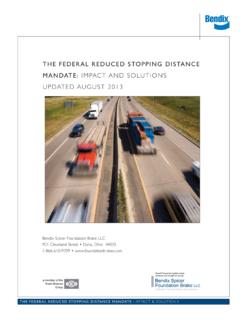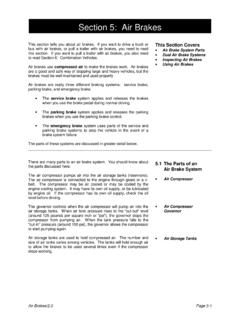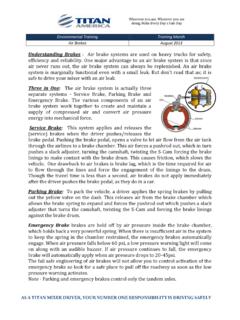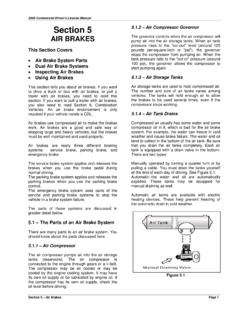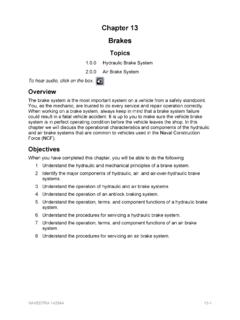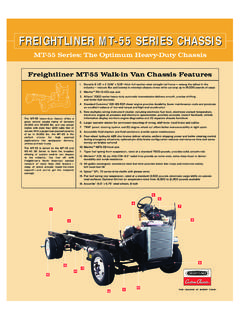Transcription of THE COMPELLING CASE FOR AIR DISC BRAKES IN …
1 THE COMPELLING case FOR AIR disc BRAKES IN HEAVY TRUCK BRAKING: A WHITE PAPERB endix Spicer Foundation brake LLC 901 Cleveland Street Elyria, Ohio 44035 1-866-610-9709 TRUCK BRAKING & AIR disc BRAKESTABLE OF CONTENTSHEAVY TRUCK BRAKING & AIR disc BRAKES21 : The Evolution of Air disc BRAKES ..32 : The Physics of Foundation BRAKES .. 4-53 : Types of Commercial Vehicle Foundation BRAKES .. 6-9a. S-Cam Brakesb. Wedge Brakesc. Air disc Brakes4 : Current-Generation Air disc BRAKES .. 10-165 : Addressing New Stopping Distance Requirements in the United States .. 17-186 : The Growing Popularity of Air disc BRAKES on Today s Heavy Trucks .. 19 While already highly utilized in Europe and in select North American applications, air disc BRAKES are experiencing continued growth in popularity on North American highways with commercial vehicle fleets and owner-operators.
2 Previously considered a niche technology for bus, coach, fire trucks, and other special applications, air disc BRAKES are becoming increasingly sought out for over-the-road applications. The growth in this braking technology is being driven by several factors, including: the critical demand for BRAKES to respond to higher speeds and lower natural retardation; the increasing expectation for safety and performance; the need for reduced maintenance, longer service intervals, and longer lining life; reduced stopping distance requirements in the United States; and reliability improvements in disc brake EVOLUTION OF AIR disc BRAKESHEAVY TRUCK BRAKING & AIR disc BRAKES31 : 1In 2010, Peterbilt Motors became the first North American heavy truck manufacturer to offer air disc BRAKES as standard equipment on a heavy truck.
3 At the 2010 MidAmerica Truck Show, Peterbilt announced that the Bendix ADB22X air disc brake would become standard equipment on the steer axle of its Model PHYSICS OF FOUNDATION BRAKESHEAVY TRUCK BRAKING & AIR disc BRAKES42 : 1To have a full appreciation of the evolution of foundation BRAKES , we must first understand their fundamental rule of physics, the Law of Conservation of Energy, asserts that the total amount of energy in the universe remains constant over time. A corollary to this law is that energy can neither be created nor destroyed; it can only be transformed from one state to another. This fundamental rule also applies to heavy truck engines and brake systems. In the case of the diesel engine, the potential energy energy stored in a body is the diesel stored in the fuel tank.
4 This potential energy is converted to kinetic energy energy associated with motion by the engine and drive train. While the drive train s key role is to move the vehicle, it is the primary responsibility of the braking system to bring it to a stop. Energy EquationThe role of the foundation brake is to reduce the velocity of the vehicle to slow it down. The heavier the load and higher the speed, the greater the kinetic energy and, subsequently, the greater the braking demand. Kinetic energy is defined by the equation: KE = MV2In this equation, KE is kinetic energy, M is mass or load, and V is velocity or speed. When considering this equation, two things are clear: (1) the impact of vehicle weight on braking demand is significant, but linear; and (2) the impact of speed on brake demand is exponential.
5 When factoring in the Law of Conservation of Energy, the kinetic energy of the moving vehicle must somehow be transformed as the vehicle slows and eventually stops. In the case of the braking system, this energy is transferred into work and heat. The brake systems ability to generate the required torque to slow the vehicle, and then dissipate this heat into the atmosphere, becomes the most important aspect of any vehicle braking the bathtub illustration, the amount of water the tub can hold is its capacity. In the case of the braking system, thermal capacity is largely dependent upon the size, shape, and material of the drum or rotor. Drum and rotor materials are primarily made of cast iron, an economic material that provides the needed thermal capacity.
6 Lighter-weight drum designs use less cast iron or a combination of iron and steel to achieve reduced weight. Unfortunately, this weight reduction comes at the expense of the system s thermal with the bathtub analogy, the rate at which water is added to the tub by the faucet is similar to the rate at which the braking system adds heat to its capacity as it transforms energy into heat during active braking. As the BRAKES are applied, the temperature increases. In this example, as water continues to fill the tub, the drain simultaneously removes water, preventing it from overflowing. In a steady-state condition, the tub must drain faster than the faucet adds water. The function of the drain is similar to the brake system s objective to dissipate heat.
7 An example of how this analogy applies to the braking system is illustrated in sustained downhill braking. In this situation, the BRAKES are used constantly, adding heat to the system over a sustained period of time without the luxury of a complete cool down. Going back, once again, to the bathtub illustration, we analyze what will happen if the drain is unable to keep pace with the rate at which water is being added. In this scenario, the tub will overflow. Overflowing water means that the capacity of the system has been exceeded. This is parallel to the braking phenomena known as fade. Fade is the condition in which the thermal capacity of the braking system has been exceeded and the system operates at reduced TRUCK BRAKING & AIR disc BRAKES52 : 2 Heat Dissipation and Thermal CapacityAs the brake system converts energy into heat, two factors become important: (1) the amount of heat the system can retain commonly referred to as thermal capacity; and (2) the rate at which it releases that heat into the atmosphere, known as the heat dissipation rate.
8 To illustrate this point, we can use the analogy of a common Available=Proper brake Function and Stopping PowerNormal BrakingCapacity Exceeded= brake Fadeand Reduced Stopping PowerBrake FadeCapacity Available=Proper brake Function and Stopping PowerNormal BrakingCapacity Exceeded= brake Fadeand Reduced Stopping PowerBrake FadeHEAVY TRUCK BRAKING & AIR disc BRAKES63 : 1 Foundation Drum BrakesS-Cam BrakesThe most common type of foundation drum brake is the S-Cam brake , commonly referred to simply as Cam or Drum BRAKES . Cam BRAKES are actuated by applying input force from an air chamber or actuator. This force acts against a lever arm, which doubles as a slack adjuster to turn the camshaft. The head of the camshaft actuates both BRAKES shoes and resembles the letter S.
9 It is this feature that gives the S-Cam brake its name. Because of their simple design, relatively light weight, and economic cost, S-Cam BRAKES are currently used on approximately 95 percent of all North American Class 5-8 air-braked vehicles. Since 1995, all air- brake equipped vehicles in the United States and in Canada have been required to use automatic slack adjusters, commonly referred to as ASAs or simply slack adjusters. The ASA keeps the brake in constant adjustment by advancing the camshaft forward as the friction material wears. As the slack moves to and from its reference point, it advances its position as the specified brake application stroke is exceeded. This helps the vehicle maintain a reasonable brake stroke as the brake lining wears.
10 The ASA is integrated into the brake lever and is generally mounted toward the inboard side of the chassis, along with the air chamber and parking brake . Wedge BrakesAlthough no longer common in North American applications, the other major drum brake design is the Wedge brake . There are two types of Wedge BRAKES : Simplex (single actuation) and Duplex (dual actuation). With greater complexity, cost, and relatively high hysteresis (release responsiveness), Wedge BRAKES have been relegated to specialty and niche applications where their robust sealing, compact packaging, and durability warrant the added weight and cost. Unlike the S-Cam brake , the Wedge brake s adjusting mechanism is incorporated into the housing of the brake OF COMMERCIAL VEHICLE FOUNDATION BRAKESS-CamAutomatic Slack Adjuster (ASA)SimplexWedgeDuplexWedgeHEAVY TRUCK BRAKING & AIR disc BRAKES73 : 2As a result of their design, all drum BRAKES S-Cam and Wedge incorporate a varying internal amplification, which is expressed by the brake factor C*.

